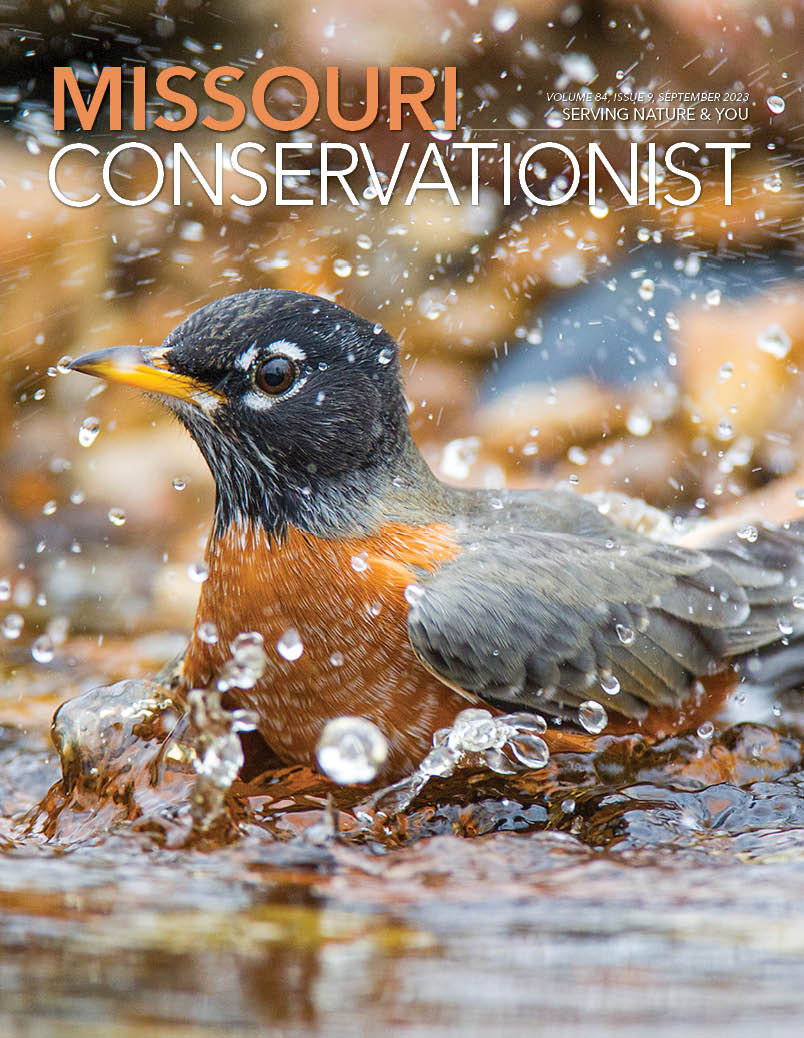Don’t Forget the Fall Flowers
Much of our early fall color in Missouri is due to flowers. Occurring along roadsides, native wildflowers — such as goldenrod, ironweed, thoroughwort, sunflower, native aster, crownbeard, and rosinweed — bloom among grasses.
Missouri has 24 species of asters, plus many hybrids and varieties, that provide late-season nectar for insect pollinators. As they age, the yellow center turns reddish. This tells pollinators to bypass the ones that are already pollinated. Keeping the old flowers open alongside the newer ones also helps draw in pollinators from greater distances.
The Early Show
When most people think of fall color, they think of October, and rightfully so. But, if October is the grand finale, September is the matinee. Fall color season begins with the brilliant reds of sumacs, Virginia creeper, and dogwoods contrasting with the yellow, early turning trees such as hackberries, black walnut, green ash, and cottonwood. Sassafras is often overlooked as a fall color tree, but it’s truly one of our standouts. Early fall is the one time of year we can appreciate poison ivy — for its brilliant red color. So don’t wait for October. Get out and enjoy the early show!
Fall Visitor
American white pelicans migrate through Missouri in the fall as they head for their wintering locations south. Polish up those binoculars and get to a body of water because these visitors won’t stay long. These immense white waterbirds are fun to watch.
What’s That Sound?
Plan a self-guided driving tour to Peck Ranch Conservation Area or Current River Conservation Area. Not only will you see beautiful fall color, but you might hear some unusual sounds — from Missouri’s elk herd. Elk are vocal mammals issuing a variety of calls and sounds, including the male’s well-known screaming “bugle,” grunts, mews, and barks. You may also hear a “knuckle cracking” sound, produced by an elk’s front legs when walking as a means of maintaining contact with the herd when moving through heavy cover. These members of the deer family are a sight to behold.
Dalton Happenings: September
Tuesday, Sept. 12, 12:30–1 p.m.
Online
Registration required by Sept. 11. For more information, call 888-283-0364 or visit short.mdc.mo.gov/4W2.
All ages.
Come join us for an inside look at what staff do to keep the range up and running. We will take you to a part of the range and show you how we take care of things, from the target frames to filling the trap and skeet machines. We will also discuss upcoming programs. This is a new monthly virtual series that we are doing for our shooters and visitors. You will receive a link to log on the morning of the program.
National Hunting and Fishing Day
Saturday, Sept. 23, 11 a.m.–4:30 p.m.
Andy Dalton Shooting Range
4897 N. Farm Road 61, Ash Grove, MO 65604
Registration not required. For more information, call 417-742-4361 or visit short.mdc.mo.gov/4W6.
All ages.
Each year on the fourth Saturday in September, we celebrate National Hunting and Fishing Day by providing one free hour of shooting on the rifle/pistol range, shotgun patterning range, or the archery range. For shotgun shooters, we allow one free round of trap or skeet. Bring your own firearms and ammunition to participate. Regular check-in, hours, and fees apply for other hours/rounds needed.
Find more events in your area at mdc.mo.gov/events
Poaching Hurts Missouri Wildlife
Poaching hurts Missouri wildlife and those who appreciate it as hunters, anglers, and nature watchers. Missourians can protect nature by reporting poaching to the Operation Game Thief (OGT) hotline.
If you witness or suspect a wildlife violation, report it to your local conservation agent or call the OGT 24-hour, toll-free number 800–392–1111. You may remain anonymous, and you may be considered for a reward.
Natural Events to See This Month
Here’s what’s going on in the natural world.
- Tree swallows migrate south.
- Freshwater jellyfish swim in warm, still ponds and lakes.
- Female black-and-yellow garden spiders build conspicuous webs.
And More...
This Issue's Staff
Editor - Angie Daly Morfeld
Associate Editor - Larry Archer
Photography Editor - Cliff White
Staff Writer - Kristie Hilgedick
Staff Writer - Joe Jerek
Staff Writer – Dianne Van Dien
Designer - Shawn Carey
Designer - Marci Porter
Photographer - Noppadol Paothong
Photographer - David Stonner






















